Mechanical Strength Degradation in Deep Coal Seams Due to Drilling Fluid Invasion
Abstract
1. Introduction
2. Experimental Program
- UItimaIV X-ray Diffractometer
- Quanta 250 FEG Field Emission Environmental Scanning Electron Microscope
- MTS High-Temperature and High-Pressure Triaxial Testing Machine
- MCXS-3 Friction Coefficient Measuring Device
- Linear Expansion and Rolling Recovery Test Apparatus
3. Results and Discussion
3.1. Mineral Composition and Microstructural Characteristics of Coal Rocks
3.2. Physicochemical Properties of Coal Rock Linear Expansion and Hydration Dispersion
3.3. Mechanical Strength Degradation of Coal Rocks After Drilling Fluid Soaking
3.4. Friction Coefficient of Coal Rocks Under Different Treatment Conditions
4. Conclusions
- (1)
- Drilling fluid infiltration significantly reduces both Young’s modulus and compressive strength. Under a confining pressure of 0 MPa, Young’s modulus decreased from 1988.1 MPa to 1676.1 MPa (a 15.69% reduction) and the compressive strength dropped from 7.9 MPa to 6.5 MPa (a 17.72% reduction). While cohesion remained nearly unchanged, the internal friction angle was almost halved, indicating enhanced sliding between microcrack surfaces. These findings suggest that the deterioration in mechanical properties is mainly due to microcrack sliding influenced by the coal’s heterogeneous structure, rather than hydration-induced dispersion or clay expansion.
- (2)
- The enhancement of sliding effects is the primary mechanism for mechanical strength degradation. Although drilling fluid infiltration has a limited impact on coal rock cohesion, it significantly reduces the internal friction angle. This indicates that drilling fluid infiltration enhances the relative sliding effects between microcrack contact surfaces, making them more susceptible to displacement and failure under stress, thereby causing a reduction in mechanical strength.
- (3)
- Friction coefficient tests showed that simulated formation water reduced the coal rock friction coefficient by 19.22%, whereas drilling fluid treatment resulted in a 25.00% reduction. This greater decrease is attributed to the combined lubrication effects of water molecules and additives, which further lower sliding resistance at contact surfaces and, consequently, increase the risk of mechanical strength degradation and borehole instability. Therefore, selecting appropriate anti-collapse additives could help improve borehole stability.
Author Contributions
Funding
Data Availability Statement
Conflicts of Interest
Abbreviation
| CBM | Deep coalbed methane |
References
- Li, S.; Qin, Y.; Tang, D.; Shen, J.; Wang, J.; Chen, S. A comprehensive review of deep coalbed methane and recent developments in China. Int. J. Coal Geol. 2023, 279, 104369. [Google Scholar] [CrossRef]
- Xu, F.; Hou, W.; Xiong, X.; Xu, B.; Wu, P.; Wang, H.; Feng, K.; Yun, J.; Li, S.; Zhang, L.; et al. The status and development strategy of coalbed methane industry in China. Pet. Explor. Dev. 2023, 50, 765–783. [Google Scholar]
- Lu, Y.; Zhao, G.; Ge, Z.; Jia, Y.; Tang, J.; Gong, T.; Huang, S.; Li, Z.; Fu, W.; Mi, J. Challenges and development direction of deep fragmented soft coalbed methane in China. Earth Energy Sci. 2024, 1, 38–64. [Google Scholar] [CrossRef]
- Guo, W.; Wang, G.; Li, Y.; Chen, D. Research on coal wall failure and stability control technology of large coal seams with a soft and thick seam. Energy Sci. Eng. 2024, 12, 3599–3613. [Google Scholar] [CrossRef]
- Zhang, J.; Zhang, Y.; Song, Z.; Wu, S.; Fan, W.-B.; Dong, X.; Yao, Z. Study on the mechanism of coal pillar instability in coal seam sections containing gangue. Phys. Chem. Earth Parts A/B/C 2023, 132, 103502. [Google Scholar] [CrossRef]
- Hou, Q.; Li, H.; Fan, J.; Ju, Y.; Wang, T.; Li, X.; Wu, Y. Structure and coalbed methane occurrence in tectonically deformed coals. Sci. China Earth Sci. 2012, 55, 1755–1763. [Google Scholar] [CrossRef]
- Ma, Q.; Tan, Y.; Liu, X.; Gu, Q.; Li, X. Effect of coal thicknesses on energy evolution characteristics of roof rock-coal-floor rock sandwich composite structure and its damage constitutive model. Compos. Part B Eng. 2020, 198, 108086. [Google Scholar] [CrossRef]
- Wu, G.; Yu, W.; Zuo, J.; Du, S. Experimental and theoretical investigation on mechanisms performance of the rock-coal-bolt (RCB) composite system. Int. J. Min. Sci. Technol. 2020, 30, 759–768. [Google Scholar] [CrossRef]
- Pan, J.; Meng, Z.; Hou, Q.; Ju, Y.; Cao, Y. Coal strength and Young’s modulus related to coal rank, compressional velocity and maceral composition. J. Struct. Geol. 2013, 54, 129–135. [Google Scholar] [CrossRef]
- Jaiswal, A.; Shrivastva, B. Numerical simulation of coal pillar strength. Int. J. Rock Mech. Min. Sci. 2009, 46, 779–788. [Google Scholar] [CrossRef]
- Bieniawski, Z. In situ strength and deformation characteristics of coal. Eng. Geol. 1968, 2, 325–340. [Google Scholar] [CrossRef]
- Chen, G.; Tang, W.; Chen, S.; Wang, E.; Wang, C.; Li, T.; Zhang, G. Damage Effect and Deterioration Mechanism of Mechanical Properties of Fractured Coal–Rock Combined Body Under Water–Rock Interaction. Rock Mech. Rock Eng. 2024, 58, 513–537. [Google Scholar] [CrossRef]
- Gao, F.; Kang, H.; Yang, L. Experimental and numerical investigations on the failure processes and mechanisms of composite coal–rock specimens. Sci. Rep. 2020, 10, 13422. [Google Scholar] [CrossRef] [PubMed]
- Shan, P.; Li, W.; Lai, X.; Zhang, S.; Chen, X.; Wu, X. Research on the response mechanism of coal rock mass under stress and pressure. Materials 2023, 16, 3235. [Google Scholar] [CrossRef]
- Gentzis, T.; Deisman, N.; Chalaturnyk, R.J. Effect of drilling fluids on coal permeability: Impact on horizontal wellbore stability. Int. J. Coal Geol. 2009, 78, 177–191. [Google Scholar] [CrossRef]
- Zhao, X.; Qiu, Z.; Wang, M.; Xu, J.; Huang, W. Experimental investigation of the effect of drilling fluid on wellbore stability in shallow unconsolidated formations in deep water. J. Pet. Sci. Eng. 2019, 175, 595–603. [Google Scholar] [CrossRef]
- He, S.; Liang, L.; Zeng, Y.; Ding, Y.; Lin, Y.; Liu, X. The influence of water-based drilling fluid on mechanical property of shale and the wellbore stability. Petroleum 2016, 2, 61–66. [Google Scholar] [CrossRef]
- Yu, J.; Tahmasebi, A.; Han, Y.; Yin, F.; Li, X. A review on water in low rank coals: The existence, interaction with coal structure and effects on coal utilization. Fuel Process. Technol. 2013, 106, 9–20. [Google Scholar] [CrossRef]
- Cao, D.; Li, X.; Zhang, S. Influence of tectonic stress on coalification: Stress degradation mechanism and stress polycondensation mechanism. Sci. China Ser. D Earth Sci. 2007, 50, 43–54. [Google Scholar] [CrossRef]
- Liu, X.; Tan, Y.; Ning, J.; Lu, Y.; Gu, Q.H. Mechanical properties and damage constitutive model of coal in coal-rock combined body. Int. J. Rock Mech. Min. Sci. 2018, 110, 140–150. [Google Scholar] [CrossRef]
- Liu, J.; Wang, E.-Y.; Song, D.-Z.; Yang, S.-L.; Niu, Y. Effects of rock strength on mechanical behavior and acoustic emission characteristics of samples composed of coal and rock. J. China Coal Soc. 2014, 39, 685–691. [Google Scholar]
- Xie, H.; Gao, M.; Zhang, R.; Peng, G.; Wang, W.; Li, A. Study on the mechanical properties and mechanical response of coal mining at 1000 m or deeper. Rock Mech. Rock Eng. 2019, 52, 1475–1490. [Google Scholar] [CrossRef]
- Cheng, Z.-B.; Li, L.-H.; Zhang, Y.-N. Laboratory investigation of the mechanical properties of coal-rock combined body. Bull. Eng. Geol. Environ. 2020, 79, 1947–1958. [Google Scholar] [CrossRef]
- Lu, J.; Huang, G.; Gao, H.; Li, X.; Zhang, D.; Yin, G.Z. Mechanical properties of layered composite coal–rock subjected to true triaxial stress. Rock Mech. Rock Eng. 2020, 53, 4117–4138. [Google Scholar] [CrossRef]
- Yao, Q.; Wang, W.; Zhu, L.; Xia, Z.; Tang, C.; Wang, X. Effects of moisture conditions on mechanical properties and AE and IR characteristics in coal–rock combinations. Arab. J. Geosci. 2020, 13, 615. [Google Scholar] [CrossRef]
- Deng, J.; Ren, S.-J.; Xiao, Y.; Shu, C.-M. Mechanical properties of coal and rock mass under thermo-mechanical coupling. Arab. J. Geosci. 2019, 12, 398. [Google Scholar] [CrossRef]
- Vaziri, H.H.; Wang, X.; Palmer, I.D.; Khodaverdian, M.; McLennan, J. Back analysis of coalbed strength properties from field measurements of wellbore cavitation and methane production. Int. J. Rock Mech. Min. Sci. 1997, 34, 963–978. [Google Scholar] [CrossRef]
- Fan, L.; Liu, S. Fluid-dependent shear slip behaviors of coal fractures and their implications on fracture frictional strength reduction and permeability evolutions. Int. J. Coal Geol. 2019, 212, 103235. [Google Scholar] [CrossRef]

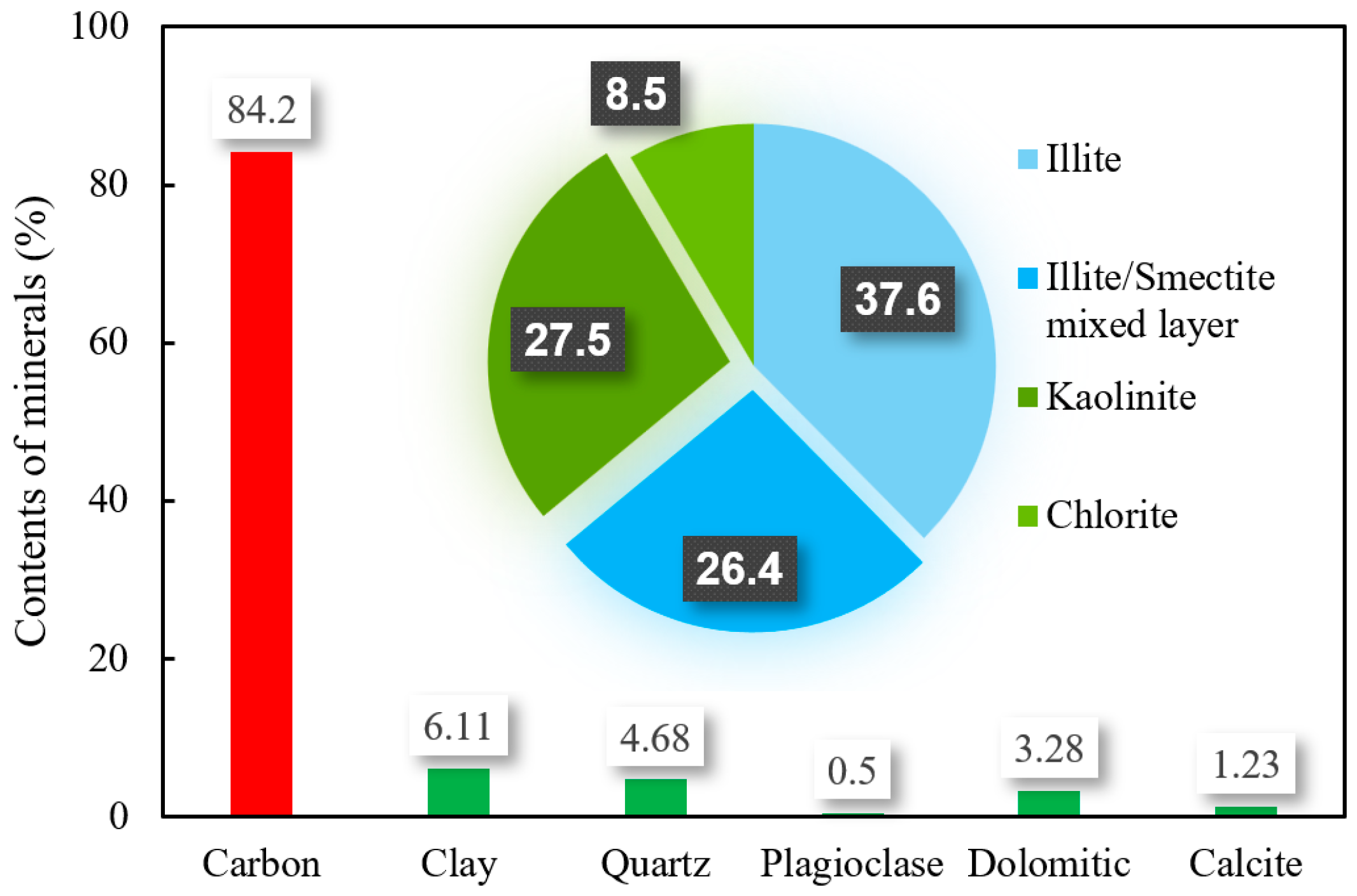

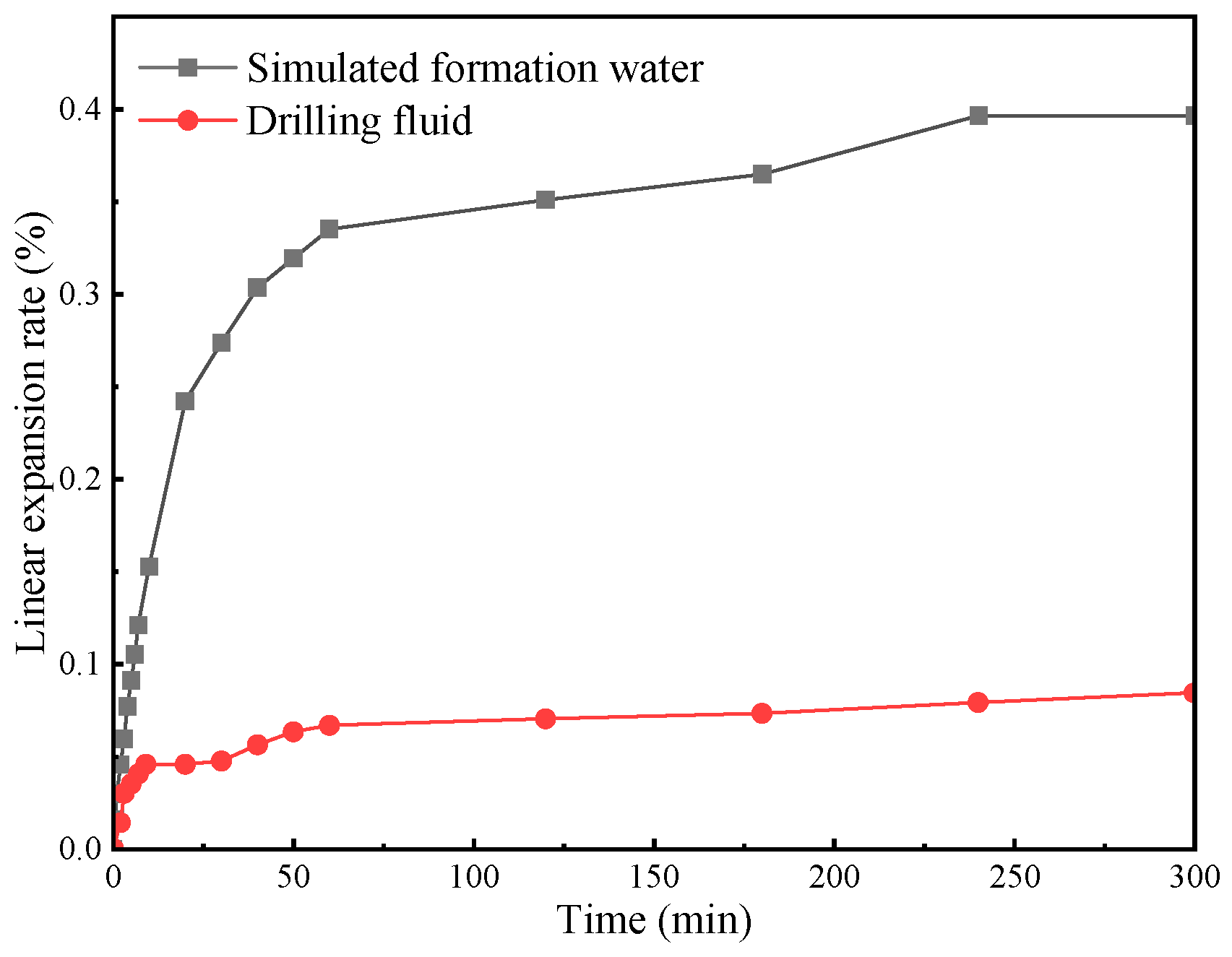
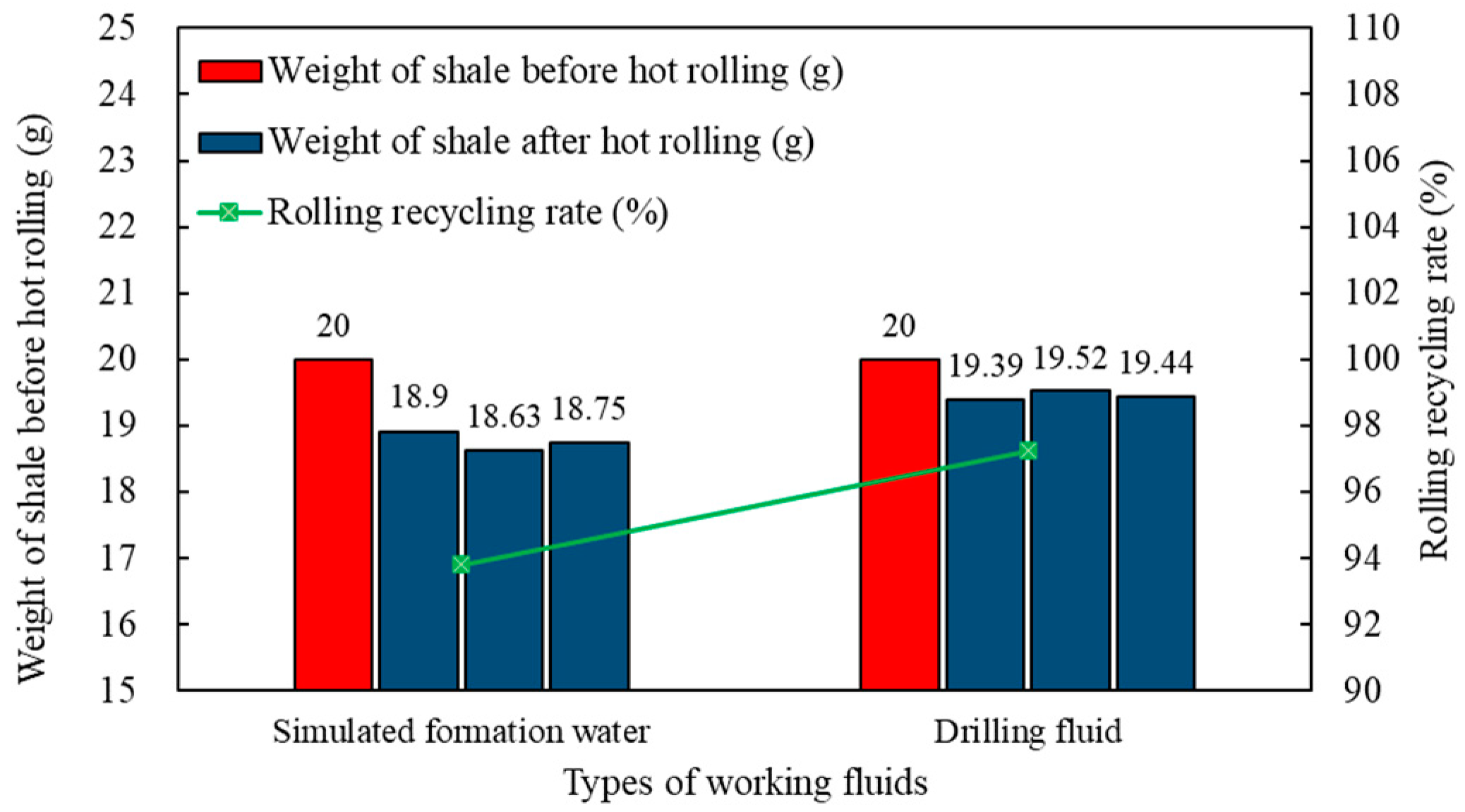
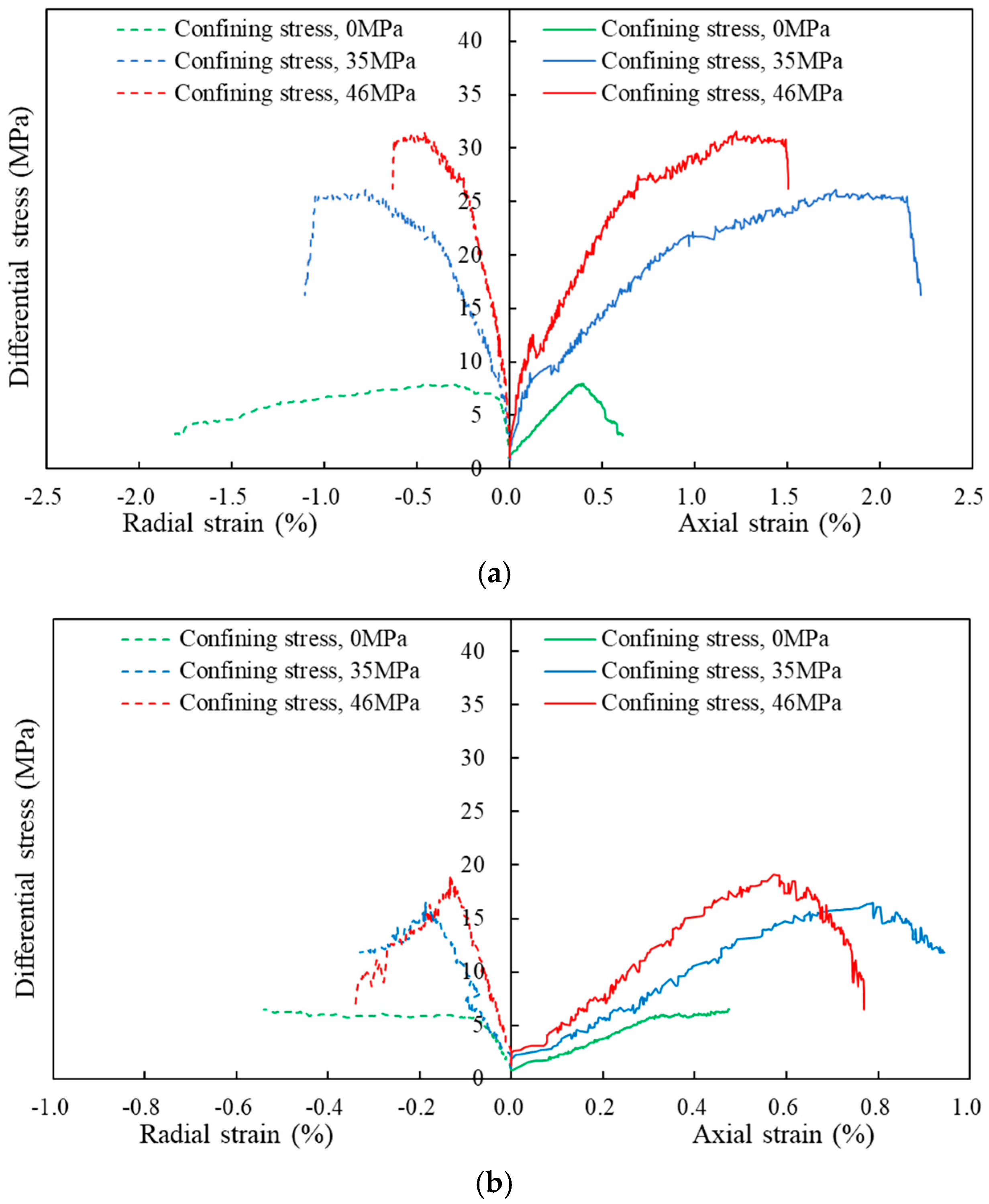

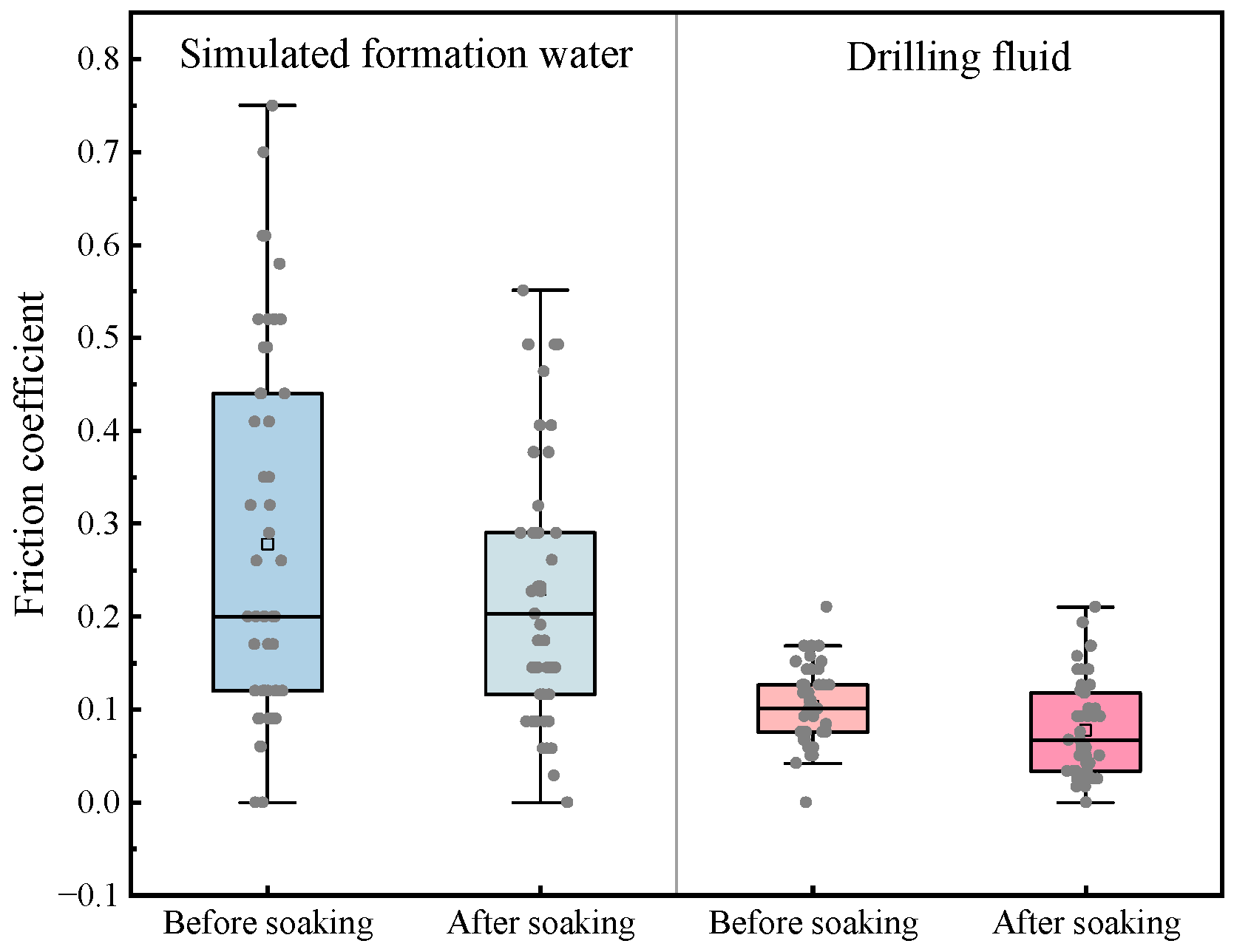
| Experimental Type | Experimental Content | Experimental Conditions | Experimental Purpose | Experimental Instrument |
|---|---|---|---|---|
| Microstructural Analysis | X-ray Diffraction (XRD) | Analyze the whole-rock minerals and clay components of the sample | Determine the mineral composition and content | UItima IV X-ray Diffractometer (Japan, Rigaku Corporation) |
| Scanning Electron Microscopy (SEM) | Compare the fracture and cleat parameters of the sample before and after drilling fluid immersion | Evaluate the damage degree of drilling fluid to the weak, microstructural surfaces of coal rock | Quanta 250 FEG Field Emission Environmental SEM (USA, FEI Company) | |
| Hydration Expansion Evaluation | Linear Expansion Test | Compare the linear expansion rate of coal rock tablets immersed in simulated formation water and drilling fluid at 110 °C for 5 h | Reveal the water absorption and expansion properties of coal rock in different working fluids | Custom-made instrument |
| Hydration Dispersion Test | Compare the hydration dispersion ability of coal rock after immersion in simulated formation water and drilling fluid for 12 h | Reveal the water absorption and hydration dispersion properties of coal rock in different working fluids | Custom-made instrument | |
| Mechanical Strength Degradation Evaluation | Triaxial Compression Test | Test the mechanical properties of coal rock under confining pressures of 0 MPa, 35 MPa, and 46 MPa before and after 12 h of drilling fluid immersion | Characterize the mechanical degradation of coal rock caused by drilling fluid | MTS Rock High-Temperature and High-Pressure Triaxial Testing Instrument (USA, MTS Systems Corporation) |
| Friction Coefficient Test | Compare the friction coefficients of coal rock contact surfaces treated with simulated formation water and drilling fluid | Reveal the damage mechanism of weak micro structural surfaces in coal rock | MCXS-3 Friction Coefficient Measuring Instrument (Custom-made instrument) |
| Type of Coal Rock | Confining Stress (Mpa) | Poisson’s Ratio | Elastic Modulus (Mpa) | Differential Stress (Mpa) | Compressive Strength (Mpa) | Cohesion (Mpa) | Internal Friction Angle (°) |
|---|---|---|---|---|---|---|---|
| Not soaked in drilling fluid | 0 | 0.139 | 1988.1 | 7.9 | 7.9 | 2.86 ± 0.87 | 12.35 ± 1.05 |
| 35 | 0.115 0.175 | 18,614.5 12,893.4 | 25.4 26.4 | 60.4 61.4 | |||
| 46 | 0.398 0.279 | 10,712.9 11,359.2 | 31.5 33.2 | 77.5 79.2 | |||
| Soaked in drilling fluid for 12 h | 0 | 0.253 | 1676.1 | 6.5 | 6.5 | 2.86 ± 1.05 | 7.43 ± 1.55 |
| 35 | 0.256 0.249 | 3315.6 3369.7 | 16.5 17.3 | 51.5 52.3 | |||
| 46 | 0.273 0.356 | 3417.7 3345.2 | 19.2 21.2 | 65.2 67.2 |
| Weight of Coal Rock (Kg) | Type of Working Fluid | Treatment Condition | Average Friction Force (N) | Friction Coefficient | Weaken Degree (%) |
|---|---|---|---|---|---|
| 0.345 | Simulated formation water | Before soaking treatment | 0.097 | 0.281 | 19.22 |
| After soaking treatment | 0.078 | 0.227 | |||
| 1.187 | Drilling fluid | Before soaking treatment | 0.123 | 0.104 | 25.00 |
| After soaking treatment | 0.092 | 0.078 |
Disclaimer/Publisher’s Note: The statements, opinions and data contained in all publications are solely those of the individual author(s) and contributor(s) and not of MDPI and/or the editor(s). MDPI and/or the editor(s) disclaim responsibility for any injury to people or property resulting from any ideas, methods, instructions or products referred to in the content. |
© 2025 by the authors. Licensee MDPI, Basel, Switzerland. This article is an open access article distributed under the terms and conditions of the Creative Commons Attribution (CC BY) license (https://creativecommons.org/licenses/by/4.0/).
Share and Cite
Zhang, Q.; Wang, W.; Zhu, M.; Zhang, Y.; Wang, Q.; Sun, H.; She, J. Mechanical Strength Degradation in Deep Coal Seams Due to Drilling Fluid Invasion. Processes 2025, 13, 1222. https://doi.org/10.3390/pr13041222
Zhang Q, Wang W, Zhu M, Zhang Y, Wang Q, Sun H, She J. Mechanical Strength Degradation in Deep Coal Seams Due to Drilling Fluid Invasion. Processes. 2025; 13(4):1222. https://doi.org/10.3390/pr13041222
Chicago/Turabian StyleZhang, Qin, Weiliang Wang, Mingming Zhu, Yanbing Zhang, Qingchen Wang, Huan Sun, and Jiping She. 2025. "Mechanical Strength Degradation in Deep Coal Seams Due to Drilling Fluid Invasion" Processes 13, no. 4: 1222. https://doi.org/10.3390/pr13041222
APA StyleZhang, Q., Wang, W., Zhu, M., Zhang, Y., Wang, Q., Sun, H., & She, J. (2025). Mechanical Strength Degradation in Deep Coal Seams Due to Drilling Fluid Invasion. Processes, 13(4), 1222. https://doi.org/10.3390/pr13041222





